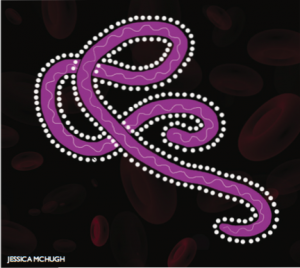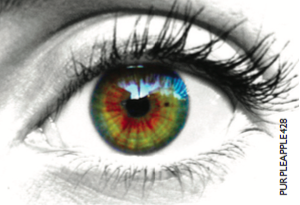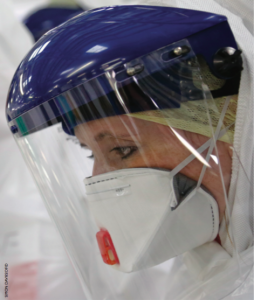SUNDAY, 14 FEBRUARY 2016
With the media attention surrounding the situation having long since faded away, it is easy to forget about the West Africa Ebola epidemic, despite its magnitude. It dwarfed all previous outbreaks of the disease: a total of 28,607 cases and 11,314 deaths have been reported since the first confirmed case in March 2014, compared to the usual 500 cases each year. The actual figures are probably even higher, given the difficulty collecting data. However, with the epidemic apparently dying down in the three worst affected countries, Liberia, Sierra Leone and Guinea, the immediate danger has now dissipated – or so it appears.
It began in spring 2015 when the May issue of the New England Journal of Medicine described the detection of Ebola virus in the right eye of Dr Ian Crozier, a US doctor who had already recovered from the illness. In October 2014, he was discharged from hospital with no sign of the virus remaining in his blood, but two months later developed inflammation and very high blood pressure in his eye, causing blurred sight and pain. It was even reported that the colour of his iris changed from blue to green. His eye fluid was found to contain levels of Ebola virus even higher than had been in his blood. Over three months of treatment with steroids and antiviral drugs at Emory Eye Centre his vision improved – and his original eye colour returned – although the episode raised questions about the persistence of Ebola virus in the body. Crozier himself thought it was unlikely to be a widespread phenomenon, saying “The likely thing is that I’m an outlier” in a video released by Emory University.
However, reports of survivors in West Africa experiencing a range of debilitating symptoms soon began to build up. The issues reported are many and varied; they include joint, muscle and chest pain, chronic fatigue, neurological problems, loss of hearing, sleep difficulties, severe headaches and memory problems. Visual problems, such as those experienced by Dr Crozier, are also common among survivors. In a WHO article, Margaret Nanyonga, a psychosocial support officer in Kenema, Sierra Leone said, “Some complain of clouded vision, but for others the visual loss is progressive. I have seen people who are now blind.” More than half of the survivors in West Africa are thought to be experiencing some of these symptoms – which together have been termed post-Ebolavirus disease syndrome (PEVDS).
Symptoms similar to PEVDS have been observed after past outbreaks of virus. The long-term health consequences of the 2007 outbreak of Bundibugyo ebolavirus in Uganda were studied in detail: survivors provided information about their health status 29 months after the outbreak. The results showed that survivors of Bundibugyo ebolavirus infection were at significantly greater risk than people in the control group (i.e. people who had not been infected) for long-term health problems comparable to PEVDS.
The current problem is that the sheer number of survivors of the West Africa outbreak with PEVDS was completely unanticipatedb and it involves countries with healthcare systems that have already been stretched to the limit by the epidemic itself, so providing adequate care for survivors has been challenging.
So far, there is only one confirmed person for whom PEVDS has been life-threatening. In October 2015, British nurse Pauline Cafferkey was admitted in critical condition to a London hospital, after experiencing renewed symptoms of Ebola, which she had caught while working in West Africa last December. Her condition was updated to ‘serious but stable’ and she is expected to remain in the isolation unit for some time. Medics who worked during the epidemic say there have also been cases like Cafferkey’s in West Africa, but with patchy reporting it is difficult to estimate the scale of the issue.
The causes of PEVDS are poorly understood, revealing yet again how little we know about the virus. That said, the list of explanations can be narrowed down; currently there are three main possibilities. With such a range of symptoms, it is probable that PEVDS develops due to a combination of these potential causes. The first is that the symptoms may be the result of damage to cells and organs by the virus before it was brought under control. Another possibility is that the symptoms are a sign the immune system has turned on the body, mistaking native structures for the virus and targeting them. There is evidence both for and against this latter theory: one study found that the Ebola survivors with higher levels of antibodies (indicating stronger immune responses) were more likely to experience joint pain. Intriguingly, this parallels chronic fatigue syndrome, where the severity of the initial immune response plays an important role. However, blood samples obtained in the 2007 Bundibugyo study gave a more complicated picture, with Ebola-specific antibodies found in both survivors and control group. The third possible explanation has been hiding in information we already have. The extremely high levels of Ebola detected in Dr Crozier’s eye fluid demonstrated the ability of the virus to persist in parts of the body sheltered from the immune system. The presence of the virus in his – and other survivors’ – eyes were therefore the likely cause of the inflammation that led to visual problems. The more we learn about persistence of Ebola virus in different ‘immune privileged’ sites in the body, such as the eye, the morelikely it seems that this is the cause of many of the symptoms. Inflammation due to the continuing presence of virus in one such site, the central nervous system, could explain the chronic fatigue experienced by many survivors. When Cafferkey was readmitted to hospital she was treated for
meningitis, which lends support to this theory, as meningitis is the result of inflammation of the brain. The testes are similarly protected from the immune system; it now seems that the virus can remain in human testes for at least nine months after it has stopped circulating in a person’s blood, and is detectable in semen. As examples of viral persistence stack up, it might make sense to recognise PEVDS as part of the progression of Ebola, which would involve redefining the disease into an acute and chronic phase. Further evidence needs to be gathered to confirm whether this is an appropriate definition.
The persistent Ebola virus levels in localised sites in the body also have implications for survivor infectiousness. The Ebola virus is an RNA virus, meaning the transfer of its RNA is all that is required for a new infection. It seems the eye is not an infection risk to others, as viral RNA has not been found in tested tear fluids. However, this is not the case for other sites. A research team recently published evidence of a survivor in Liberia transmitting the virus sexually last March, due to its presence in hissemen. Ebola virus RNA was also found in breast milk of survivor mothers, raising fears that children could be infected by breast-feeding: Sierra Leone’s first Ebola survivor was warned not to nurse her baby until medics had confirmed there were no traces of the virus in her breast milk. Actual and potential new Ebola cases due to contact with survivors – who were previously thought to be non-infectious – could seriously hamper the final efforts to stamp out the remaining hotspots of the disease. The outbreak in West Africa continues to teach us new things about Ebola, and it is turning out to be a very costly education.
Bethan is a 1st year Natural Sciences student at King’s College



